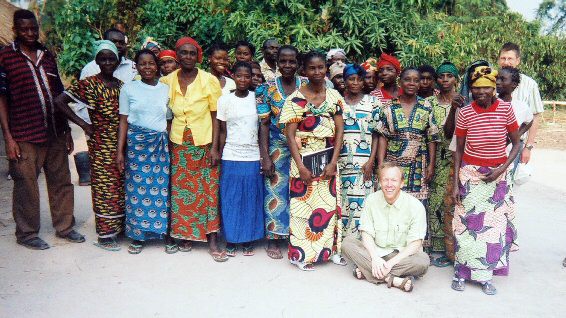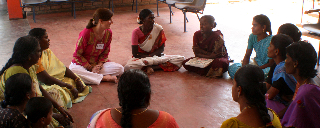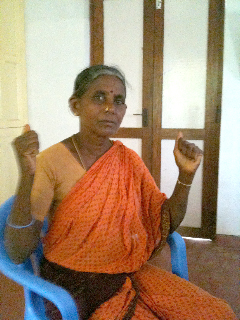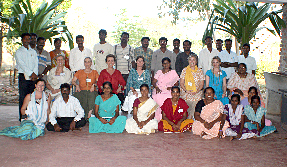Somatic Experiencing’s Application In The Former War Regions of the Democratic Republic of Congo (DRC)
In this article I’d like to share with you the trauma intervention work that’s being done using this psycho biologically based approach in former war regions of the Democratic Republic of Congo (DRC). The recent wars in DRC have claimed over 5 millions lives, leaving those remaining severely traumatized. The ongoing conflict over the past 12 years, and a recent return of conflict in 2008, left the local populations terrorized. Sadly, rape was used as a weapon, recruitment of children soldiers, and widespread civilian murders were all characteristic of this war. The Congolese people’s foods stores, crops and fields were targeted, devastating their entire infrastructure and causing severe traumatization amongst it’s people.
Anthony “Twig” Wheeler, who is an internationally recognized trauma treatment expert who specializes in Somatic Experiencing, was invited as a consultant to join in the healing and rebuilding efforts of local grassroots re-development movement in DRC . Anthony “Twig” Wheeler works in partnership with Hoskinson Consulting founded by Steve Hoskinson, a senior FHE staff member.
To give a little background of their project, with minimal financial support from European NGO’s a group of pioneering Congolese development experts in combination with partners from various religious and non-religious organizations has informed and motivated a powerful and effective grassroots movement focusing on local food production, food security and community safety and recovery. This “association movement” has galvanized individuals and communities to augment their individual family incomes by also working in small cooperative organizations or “associations” which pool work and resources as a safety net for individual members. These associations also share ideas and strategies for crop success, seed saving, trading of seed and so forth. Another deep interest of the association movement is to address the latent traumatization from the war, which has been identified as a critical impasse to full community recovery. It was this movement in DRC that invited Twig to come and look at the process of trauma and recovery.
These small associations that have been established throughout DRC are made up of like minded individuals who have come together to develop joint agricultural fields. So far they have well above 600 groups formed and counting. It’s the “animators” of the movement, who are self appointed men and women who receive a periodic training in how to facilitate meetings that keep this movement alive. One of Twig’s roles while in DRC was to meet with these animators and help them understand the basic principles of Somatic Experiencing so they could incorporate this knowledge into how they run their meetings, the intention being to help make association participants feel more safety and freedom to participate and less likely to become overwhelmed when negative experiences arise – as is likely to happen for trauma survivors unless special attention is taken to address the needs of their sensitive nervous system. It was touching for me to hear that even with the destruction of their road systems, these dedicated animators travel long distances by bicycle to different parts of DRC to share these messages of hope that a better life can be created.
The joint community efforts of these small associations create cooperative savings of seeds, grains, and earnings from selling their crops. Individuals are able to borrow small sums from the reserve savings to help pay for medical expenses and schooling for their children. These sustainable groups are helping to bring healing to the traumatized communities in that they’re supporting people to claim back their own interdependence and communal solidarity. Twig was relaying to me the value of the Congolese gaining back this control over their own lives. All control had been taken away from them by the war. The effects of this empowering community structuring have proven to be a very helpful resource for people who otherwise feel estranged, isolated, and hopeless from the devastating affects caused by the recent war.
In an interview with Twig, he relayed the ideas and aims behind the set up of the association movement. They intended these associations to be a place where people within a community could attend to their own needs, hear each other out, and not have to look to a higher authority for every answer, ending the dependency dynamic. In addition these associations serve as a communal meeting places where pressing issues could be discussed and people together could find the answer to their own problems. This intention toward autonomy is reflected by the animators’ tendency to defer from taking positions of authority, preferring to act as moderators rather than experts.
Twig was explaining in our interview, the healing benefits of the establishment of this movement in terms of trauma resolution. For the individuals of DRC this community organizing is supporting the restoration of personal agency over their lives. In situations where there is repeated traumatization and severe violations, the sense of personal agency is often lost, leaving people feeling shattered, and helpless. These joint efforts to restore a sense of empowerment over their lives, through these agricultural projects and group conversations, have been saving graces for the people of DRC. The establishment of these associations is an effective step toward providing a sense of stability in their lives. A step which will help dampen the severity of the stress response, as they look forward to what they’ve created together and draw strength from their interdependence, hearing out each others voices and concerns.
As explored earlier in this essay the trauma vortex tends to have a very strong magnetic pull, so these associations act as counter balancing resources to the dysregulation in their nervous systems brought on by their experiences in the war. Communities gather to talk about what their concerns are. They enter into these discussions of how they can support each other in improving their lives, via the stabilizing resource. Having created a source of food for their families, monetary resources from their joint efforts is something very positive, and empowering. According to Somatic Experiencing, the chances are greater of achieving stability in ones nervous system, or in a collective nervous system, if there are established resources that have counter balancing effects. These associations act as these resources.
Twig was invited by this organization to bring the wisdom of Somatic Experiencing and it’s understanding of how the body can recover from trauma into the current projects underway in DRC. With the help of Toss Mukwa of the Congo and Lothar Seethaler of Switzerland, trainings have taken place with other local organizations such as the Justice and Peace Commission, as well as to the “animators” of the Associations Movement. They provide a concise breakdown of the basic principals of Somatic Experiencing as they related to the people of DRC, with great portions dedicated to experiential learning.
Animator trainings that included the guidelines found in Somatic Experiencing have been organized to help support the association’s animators in their understanding of the dynamics of trauma and how to support their associations toward recovery. For the people of DRC, this education of how the body responds to trauma has been tremendously healing. In traumatology it’s a known principal that identifying where the threat is coming from is an essential step for an organism to begin to let down the stress response. As part of the trauma treatment protocol education was provided to the people of DRC on the dynamics of trauma for this reason.
Gaining the logical understanding of why they were feeling threatened, hypervigilant, agitated, and exhausted, was a great relief for the people to hear . In my interview with Twig we talked about the responses the Congolese shared when they started getting this inside view of why they’ve been feeling what they’re feeling. Their eyes would grow wide and they commonly would say “oh, that’s what’s been going on with me!, that’s why I’ve been feeling this way”. The normalizing of traumatic response, and the making sense for people of why they were feeling unsafe and uneasy was a big part of the educational strategy of their movement.
The next step in their protocol was to address the residual fear following the war. Traumatic experiences such as the Congolese war creates a malfunction in our body’s ability to detect relative safety. As a result individuals with trauma are constantly attempting to identify where their perceived feelings of threat are coming from. After a while of repeated unsuccessful attempts, people end up feeling afraid and on guard all the time, because the fear becomes generated from within and tends to build on itself. Their body’s interrupted self-protective responses caused by the trauma of war, and the continual activation of the fear response, is what has kept the people of DRC in this autonomic stress response. This is the nature of trauma, unintentional yet self-generated feelings of threat continue coming from within one’s own physiology. Of course in DRC there continue to be very real things in the environment that are in fact threats and are contributing to high levels of activation.
This high level of autonomic stress over such a long time period has lead the people of DRC’s physiology to the overwhelmed, and immobilized “freeze” response. Twig observed in his group meetings of women who suffered from repeated severe sexualized violence, would fall asleep during the meetings. This exhaustion was almost certainly not out of boredom of the material presented, the information Twig was sharing was of great interest to people he met there. The issue was these women’s bodies were simply overwhelmed by continuous autonomic nervous system distress.
After observing that severe level of widespread overwhelm that people were experiencing in their nervous systems, it became clear how to proceed. Twigs assessment of the situation in DRC from a psycho-biological perspective suggested that the primary needs in attending to the trauma within the communities was the continued attention toward restoring a sense of safety in their environment and developing communal and inner resources as imperative interventions. When an individual’s nervous system is at this level of overwhelm reflective in chronic immobility, it is rarely helpful to go directly into having them recount their traumatizing experiences in a catharsis. Their physiology is already on overload indicated by their observable level of numbness and frozenness. It has proven to be re-traumatizing to ask a person to drudge up their horrifying memories of war and thus counter productive. Many psychotherapeutic approaches tend to use this cathartic strategy, which only sends a person’s physiology further into the stress chemistry. The Somatic Experiencing healing paradigm is designed to attend to what feels safer first, to build nervous system resiliency, and then from that place slowly begin to access and deactivate the issues that hold higher charges in their nervous systems, such as war and the sexualized violence.
On a community wide level in the various association meetings, discussions were opened on how to decrease dangers and violence, specifically targeting women. Women were able to express their fears of going into the fields to work alone, because typically that is where the sexualized violence would occur. In these communal discussions facilitated by the animators, the group came up with the solution of working in teams in the fields, so no one ever had to feel scared and alone. Other concerns that the women expressed were their fears of walking back to their homes alone at night. Another common time for assults. So the creative solution that they came up with was that trustable men from the village were appointed to escort them home safely, so they didn’t have to walk alone. These are examples of how the groups have begun to find ways to help one another feel safer as a “logical reflection of reciprocity”.
This community re-engagement is an essential step toward supporting the restoration of a sense of safety and connection between people. The effects of the war turned friends and families against each other, creating huge breaches in what people could normally trust, disrupting communal solidarity at its core. After the war people were left feeling isolated and estranged from one another, which poses challenges in working together. Twig said in our interview, traumatized people don’t work well together especially when they’re bodies are overwhelmed, and they feel triggered and not able to join in.
These were the challenges posed to the community rebuilding efforts. The hope for this project is that entire communities can slowly begin to transform the imprint of their past experiences. Through creating feelings of safety, they could deactivate their nervous systems and land into a new found sense of connectedness and safety. This grassroots sustainable movement in itself is a tremendous resource whereby the people of DRC can begin to make small steps toward rebuilding resources and trust, preparing the ground for later renegotiations of their traumas.
I’d like to highlight the way in which Anthony Twig” Wheeler and the folks spearheading the association movement such as Toss Mukuwa of DRC and Lothar Seethaler of Switzerland have adapted the trauma educational strategies used in helping the Congolese by truly meeting and resonating with their culture. In our interview, Twig shared how they used culturally applicable analogies and a story telling approach to explain the body’s responses to stress. I appreciate the exquisite cultural sensitivities they’ve employed in their interventions, and the compassionate, creative, respectful way they’ve conducted their work in the DRC. To find out more information about the Congolese trauma interventions or the work of Anthony “ Twig” Wheeler please visit his website www.liberationispossible.com or Steve Hoskinson at Hoskinson Consulting www.hoskinsonconsulting.org.
69 “Somatic Experiencing in Democratic Republic of Congo Interview with Anthony “Twig” Wheeler.” Interview by Felicia Mihich. 15 Jan. 2010. Print.
* “Somatic Experiencing in Democratic Republic of Congo Interview with Anthony “Twig” Wheeler.” Interview by Felicia Mihich. 15 Jan. 2010. Print.




